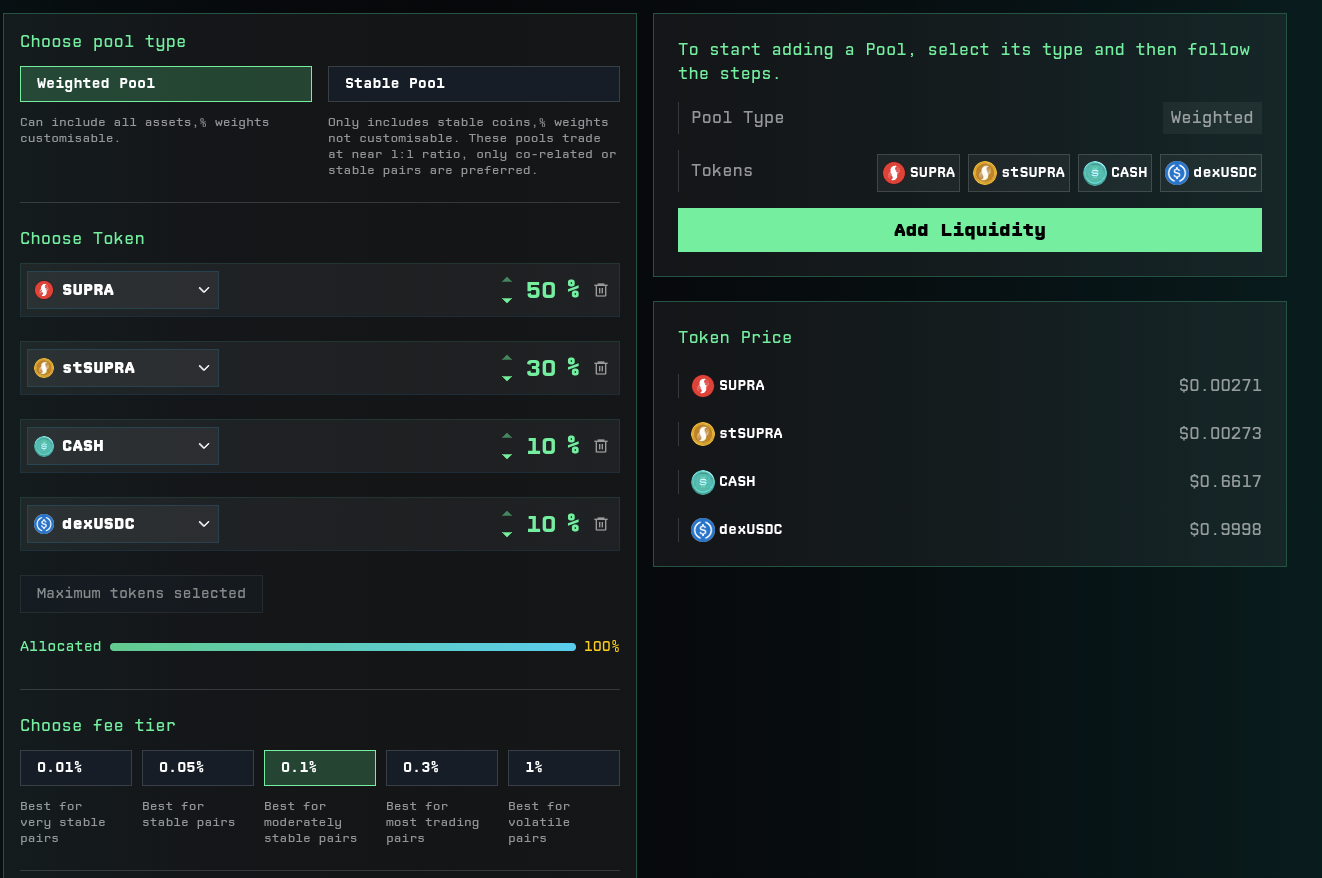Weighted Pools
Weighted Pools represent a sophisticated advancement of traditional Automated Market Maker (AMM) pools, first popularized by Uniswap. These pools utilize Weighted Math by enforcing a Constant Weighted Product invariant, making them optimal for broad and general use cases particularly for token pairings that don't necessarily share any price correlation (e.g., SUPRA and CASH, or SUPRA and iETH).
Unlike conventional AMM pools that operate on a fixed 50/50 ratio, Weighted Pools empower users to customize token ratios and support multiple tokens in a single pool. This includes configurations such as 80/20, 60/20/20, or even 25/25/25/25 weightings, enabling more nuanced strategies that align better with market conditions and individual preferences.

Technical Constraints
Weighted Pools operate under specific mathematical and security constraints:
- Minimum token weight: 1%
- Weight distribution: All weights must sum to 100%
Key Advantages
1. Higher Swap Optionality
By supporting up to 4 tokens in a single pool, Weighted Pools provide significantly more direct trading pairs compared to traditional two-token pools. Each asset in the pool can be traded against every other asset, creating multiple swap opportunities within a single liquidity source.
Available Trading Pairs Formula:
Number of pairs = n × (n-1) / 2
Where n is the number of tokens in the pool.
Examples:
- 2-token pool: 1 trading pair
- 3-token pool: 3 trading pairs
- 4-token pool: 6 trading pairs
This increased optionality promotes more trading activity, resulting in higher fee collection and better returns for liquidity providers.
2. Exposure Control
Weighted Pools allow users to choose their levels of exposure to specific assets while maintaining the ability to provide liquidity. The higher a token's weight in a pool, the less impermanent loss it will experience in the event of a price surge.
Strategic Weight Allocation:
For a pool containing isolvBTC and iETH, liquidity providers can choose weightings that align with their market outlook:
- 80% isolvBTC / 20% iETH: Indicates confidence in isolvBTC's price performance, minimizing impermanent loss for isolvBTC
- 20% isolvBTC / 80% iETH: Suggests expectation of stronger performance for iETH
- 50% isolvBTC / 50% iETH: Optimal for assets whose value is expected to remain proportional
Multi-Token Example: A 25/25/25/25 pool with iETH, CASH, SUPRA, and isolvBTC provides equal exposure to all four assets while offering 6 different direct trading pairs.
3. Impermanent Loss Mitigation
Impermanent Loss represents the opportunity cost of providing liquidity instead of holding assets directly. Weighted Pools help mitigate this loss through strategic weight distribution.
Key Principles:
- Heavily weighted tokens experience significantly less impermanent loss when their price increases
- Asymmetric pools reduce impermanent loss but may have higher swap slippage due to uneven liquidity distribution
- 80/20 pools have emerged as an optimal balance, combining impermanent loss mitigation with adequate liquidity for efficient swaps
Trade-off Consideration: While uneven weightings reduce impermanent loss for the dominant token, they result in higher slippage for swaps involving the lesser-weighted tokens due to reduced liquidity on that side of the pool.
4. Customizable Liquidity Strategies
Weighted Pools grant liquidity providers unprecedented freedom to customize asset allocations based on their market forecasts, risk tolerance, and investment strategies.
Dynamic Portfolio Management:
- Conservative approach: Higher weighting on stable or preferred assets
- Aggressive approach: Balanced weightings for maximum trading fees
- Tactical approach: Adjusting weights based on market conditions and expected price movements
Use Case Examples:
-
Bullish on Specific Token: A liquidity provider expecting a token to outperform can assign it a higher weight (e.g., 80%), reducing impermanent loss while still earning trading fees.
-
Diversified Exposure: Multi-token pools (e.g., 60/20/20) allow exposure to multiple assets while maintaining a primary position in a preferred token.
-
Market Neutral Strategy: Equal weightings across multiple uncorrelated assets can provide steady returns through trading fees while minimizing directional risk.
Best Practices
Optimal Weight Configurations
80/20 Pools: The most popular configuration for two-token pools, offering:
- Significant impermanent loss reduction for the dominant token
- Sufficient liquidity for reasonable swap efficiency
- Good balance between risk and reward
Multi-Token Strategies:
- 60/20/20: Maintains primary exposure while diversifying risk
- 40/30/30: More balanced approach with moderate concentration
- 25/25/25/25: Equal diversification across four assets
Risk Considerations
- Slippage Impact: Heavily skewed pools may experience higher slippage on swaps
- Liquidity Efficiency: Extreme weightings can reduce overall pool efficiency
- Market Correlation: Consider token correlation when designing multi-token pools
- Fee Optimization: Balance weight distribution with expected trading volume
Conclusion
Weighted Pools represent a powerful evolution in AMM technology, offering liquidity providers sophisticated tools for risk management, exposure control, and yield optimization. By supporting customizable weights and multiple tokens, these pools enable strategies that are impossible with traditional 50/50 AMMs and CLMMs.
Whether you're looking to minimize impermanent loss, maximize trading opportunities, or implement complex liquidity strategies, Weighted Pools provide the flexibility and efficiency needed for modern DeFi operations.